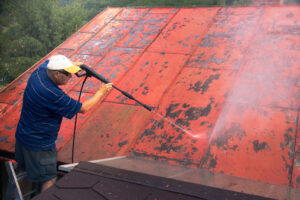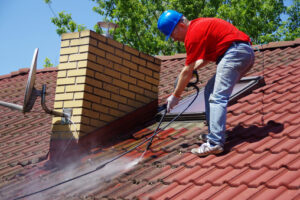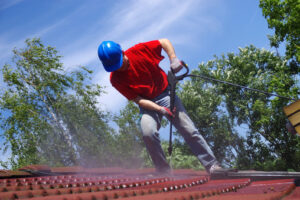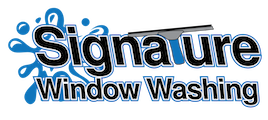 Are your roof tiles looking dull, streaked and discolored? Are you worried that it’s time to replace them? Don’t despair – the good news is that you may not need to shell out for a costly re-tiling job. Softwashing could be the answer! Softwashing is a method of cleaning roofs without using high pressure or harsh chemicals, meaning you can restore and protect your roof without damaging it. In this article, we’ll explain how to softwash a roof so you can keep it looking fresh and new.
Are your roof tiles looking dull, streaked and discolored? Are you worried that it’s time to replace them? Don’t despair – the good news is that you may not need to shell out for a costly re-tiling job. Softwashing could be the answer! Softwashing is a method of cleaning roofs without using high pressure or harsh chemicals, meaning you can restore and protect your roof without damaging it. In this article, we’ll explain how to softwash a roof so you can keep it looking fresh and new.
Softwashing is an effective way of cleaning many hard surfaces around the home, including roofs and outdoor patios. It works by using low pressure, biodegradable detergents and specialized equipment to clean the surfaces gently but thoroughly. This means that no damage is caused to the surface during the cleaning process. As well as removing dirt, stains and moss from roofs, softwashing can also help protect against future weather damage.
By following our step-by-step guide, you can learn how to softwash your own roof with ease – saving yourself time, money and hassle! Read on for all the information you need about softwashing a roof safely and effectively.
Benefits Of Softwashing A Roof
Softwashing is a great way to clean a roof without using the harsh pressure of power washing. It is much less destructive than power washing and can be done with a garden hose and mild cleaning agents. The benefit of softwashing is that it doesn’t require the force of a pressure washer, which can easily damage shingles on a roof or other surfaces.
Cleaning agents used for softwashing are specifically formulated to break down dirt, pollen, moss, and other stains that accumulate on roofs over time. They are applied at lower pressures than those used in power washing and are safe for use on most building materials such as asphalt shingles, clay tiles, cement tiles, slate, aluminum siding, stucco and more. Softwashing requires less water than power washing which means that it not only uses fewer resources but also reduces the amount of runoff into rivers and streams from runoff from the roof.
The method used in softwashing ensures that no damage will occur while still achieving outstanding results when cleaning a roof. It’s gentler on the environment than traditional power washing and provides an excellent deep clean without having to worry about any potential damage caused by high-pressure water jets or abrasive materials. In addition, softwashing can be done more frequently since there isn’t as much risk of damaging the surface being cleaned with each application.
Softwashing is an effective way to improve the look of your home while also protecting its integrity and keeping it looking new for years to come. Not only is this method safer for your home but it’s also more cost effective because it requires fewer resources than traditional methods like power washing or chemical cleaners.
Choosing The Right Equipment For Softwashing
When it comes to softwashing, choosing the right equipment is key. While pressure washers can be used in some cases, they are not recommended because they could cause damage to the roof or other surfaces being cleaned. Instead, power washers should be used when cleaning a roof with softwashing. Power washers are less powerful than pressure washers and don’t run the risk of damaging delicate surfaces.
When choosing a power washer for softwashing a roof, it’s important to make sure that it has a detergent tank and nozzle holder so that you can apply the cleaning agents safely and evenly. The pressure washer detergents used for softwashing should also be chosen carefully—they should be specifically formulated for use on roofs in order to break down dirt, pollen, moss, and other stains without harming the surface being cleaned.
Finally, it’s important to read the directions on any cleaning agents or power washers before using them. This will help ensure that you’re using them correctly and safely, as well as ensuring that you get the best results possible when softwashing your roof.
Safety Precautions To Consider Before Softwashing A Roof
Before beginning the softwashing process, there are important safety precautions to consider. Pressure washing should never be used on a roof, as it can cause damage to the delicate material. Additionally, vinyl siding should also not be pressure washed—softwashing is the best option for cleaning this type of surface.
When using wash detergents for softwashing a roof, it’s essential to wear protective clothing and eyewear in order to protect yourself from any splashes or fumes. It’s also important to read and follow all instructions on the packaging of any detergents or power washers that you use, as improper use could lead to damage to your roof or other surfaces.
It’s always wise to take necessary safety precautions when softwashing a roof. Taking the time to familiarize yourself with the cleaning agents and power washers you’re using will help ensure that you get good results without running the risk of damaging your roof.
Steps For Cleaning And Softwashing A Roof
 Now that you’re familiar with the safety precautions for softwashing a roof, it’s time to begin the cleaning process. Softwashing a roof requires more than just spraying down with a hose; here are some steps to take in order to get your roof clean and looking like new.
Now that you’re familiar with the safety precautions for softwashing a roof, it’s time to begin the cleaning process. Softwashing a roof requires more than just spraying down with a hose; here are some steps to take in order to get your roof clean and looking like new.
First, you’ll need to apply a bulk application of cleaning detergent over the entire roof. When doing this, be sure to use an even layer of detergent and avoid any heavy build-up spots or puddles. Let the detergent sit for 20 minutes so it can start breaking down dirt and debris before rinsing it off.
You may want to use a power washer on high pressure for rinsing after the detergent has had time to work its magic. This will help ensure that all of the dirt and grime is removed from your roof, leaving it clean and free of staining. Be sure that you’re using the right nozzle on your power washer—a fan-shaped nozzle is typically best for softwashing roofs—and make sure you keep a safe distance away from the surface while working.
Once you’ve rinsed off any remaining detergent residue, inspect your roof for any areas that may need more attention or extra scrubbing. If necessary, use a soft brush or sponge along with additional cleaning agents before rinsing again until all grime has been removed from your roof’s surface.
How To Identify Problem Areas On A Roof
Once you’ve finished the cleaning and softwashing process, it’s important to inspect your roof for any problem areas that may need further attention. By identifying these areas before they become an issue, you can help keep your roof in good condition and prevent costly repairs down the road.
The first step is to look for any standing water or pooling on the surface of your roof. This could be a sign of a potential leak, which should be addressed immediately. If you see any discoloration or bubbling on the shingles, this could be another indication of a potential leak and should also be inspected more closely.
Finally, look for any damage caused by debris such as branches or leaves. If you notice any holes or missing pieces in the shingles, make sure to have them repaired as soon as possible to avoid further damage to your roof. Taking care of these issues now will help ensure that your roof remains strong and healthy for years to come.
Solutions For Common Stains On A Roof
Once you have identified any problem areas, it is important to take action to address them. Softwashing is one of the most effective ways to clean and protect your roof from stains and debris. This process uses a gentle detergent solution and low-pressure water spray to remove dirt, mold, mildew, and other contaminants without damaging the roof. It can also help restore color to faded shingles and remove stubborn algae stains.
When softwashing your roof, it is important to use the right cleaning solution for the type of stain you are trying to remove. For example, heavy oil or grease stains may require a stronger degreaser while mildew may require an anti-fungal cleaner. If you are unsure which product is right for you, consult a professional who has experience with softwashing roofs in your area.
Once you’ve identified the appropriate cleaning solution for your stain, simply apply it according to the manufacturer’s instructions and allow it to sit for several minutes before rinsing off with low-pressure water. With regular maintenance and careful cleaning, you can extend the life of your roof and keep it looking great for years to come.
Common Mistakes To Avoid When Softwashing A Roof
Softwashing your roof is an important part of keeping it looking great and extending its life, but there are some common mistakes to avoid when tackling this job. Knowing these mistakes ahead of time can help you save time and money in the long run.
First, don’t assume that a higher-pressure water spray will get the job done faster. In fact, high-pressure cleaning can actually damage the roofing materials and cause unnecessary wear and tear on your shingles. It’s best to stick with low-pressure cleaning for softwashing a roof.
Second, don’t use harsh chemical cleaners that contain chlorine or other abrasive ingredients. These products can strip away the protective coating on your shingles and lead to premature deterioration of your roof. Always read the labels of any product you plan to use and make sure it is safe for use on roofs before using it.
Finally, don’t wait too long between cleanings or neglect areas where there may be stubborn stains or debris buildup. Regular maintenance is key when it comes to keeping your roof looking good and preventing damage from occurring over time. If you notice any problem areas, address them immediately with a professional softwash solution to prevent further damage down the road.
Tips For Maintaining A Softwashed Roof
 Once you’ve softwashed your roof, it’s important to take steps to ensure that it stays clean for as long as possible. Here are some tips for maintaining a softwashed roof:
Once you’ve softwashed your roof, it’s important to take steps to ensure that it stays clean for as long as possible. Here are some tips for maintaining a softwashed roof:
First, keep up with regular inspections of the roof and surrounding area. Look for signs of buildup from dirt, leaves, and other debris that can clog gutters and downspouts. If you find any blockages, make sure to clear them away so your roof can continue to drain properly.
Second, be sure to seal any seams or cracks in the shingles. This will help prevent water from seeping into the roofing materials and causing damage over time. Additionally, inspect the flashing around chimneys and other vents on the roof to make sure they are still in good condition.
Finally, consider getting a professional inspection every few years or when needed to make sure there aren’t any underlying issues with your roof. A professional can spot potential problems before they become costly repairs down the road. Plus, they can give you advice on how best to maintain your softwashed roof in between cleanings so it stays looking its best for many years to come.
How To Remove Moss And Algae From A Roof
Now that you know how to maintain your softwashed roof, it’s time to learn how to remove moss and algae from the surface. Moss and algae can be a slippery hazard and can cause damage to your roofing materials if left untreated. Luckily, there are several effective methods for removing these growths.
One of the simplest ways is to use a pressure washer with an appropriate cleaning solution. A pressure washer will help loosen up the moss and algae, making them easier to remove. Always make sure to follow the instructions on the cleaning solution carefully, as using too much could damage your roof’s shingles.
Another option is to use a brush or scrubber attachment on your pressure washer or by hand with a soft-bristled brush dipped in a cleaning solution. This method will get rid of any remaining buildup without damaging the shingles on your roof. Once you’ve removed all of the moss and algae, rinse off any remaining cleaning solution with clean water before drying completely.
No matter which method you choose, make sure that you take all necessary precautions while working on your roof such as wearing proper safety gear and having someone spot you while up there. With some regular maintenance and these simple steps, you can keep your softwashed roof looking its best for years to come!
The Difference Between Pressure Washing And Softwashing
When it comes to cleaning roofs, there are two common approaches: pressure washing and softwashing. While both methods can be effective for removing dirt, dust, and debris from a roof’s surface, they differ in the way that they approach the job.
Pressure washing is an aggressive method of cleaning that uses high-pressure streams of water to blast away debris from a surface. This method is typically used on hard surfaces like concrete or brick and can be effective in removing tough stains. However, it is not recommended for use on delicate surfaces such as shingles as it can cause damage.
Softwashing, on the other hand, is a gentler approach that relies on low-pressure spraying and specialized cleaning solutions to remove organic growths like moss and algae without damaging the roof’s surface. Softwashing also kills off any existing mold spores so that they don’t return after the cleaning has been completed. Ultimately, while pressure washing may be more suitable for some projects, softwashing is often the better option when dealing with delicate surfaces such as asphalt shingles.
When choosing a cleaning method for your roof, consider both your budget and the type of surface you’re dealing with before making a decision. If you take into account these factors and use the appropriate technique for your specific needs, you should have no problem keeping your roof looking its best!
What Type Of Cleaner Should Be Used For Softwashing?
When softwashing a roof, it is important to choose the right cleaning solution for the job. There are many types of cleaners available on the market, so it can be difficult to know which one will best suit your needs. Generally speaking, most softwashing solutions are designed for killing off organic growths such as mildew, moss, and algae. They also contain detergents or surfactants to help loosen dirt and debris from the surface before they are washed away.
In addition to these general-purpose cleaners, there are also specialist solutions available that target specific types of stains or discoloration. For instance, if you’re dealing with rust stains on your roof then you’ll need a product that is designed specifically for removing this type of stain. These types of cleaners usually contain acids or bleaches that effectively break down the stain without damaging the surrounding area.
Finally, to ensure that your roof is properly protected after cleaning it’s important to use a sealant or coating product once all of the dirt and debris has been removed. This will help protect against future staining and make sure that your roof stays looking its best for years to come!
Factors To Consider When Selecting Cleaners For Softwashing
When selecting the right cleaner to use for softwashing, there are several key factors to consider. First and foremost, you will need to determine what type of discoloration or organic growth you are dealing with. This will help narrow down your choice of cleaning solutions and ensure that you select one that is specifically designed for the job at hand.
It’s also important to consider the material of the surface you’re cleaning. Different materials require different types of cleaners, so it’s essential that you choose one that is compatible with your roof or other exterior surfaces. Additionally, some materials may require special pre-treatment before using any type of cleaner, so make sure that you read the instructions carefully before beginning your project.
Finally, always make sure that whatever product you choose is safe and appropriate for use in outdoor applications. Some cleaners may be too harsh or contain toxic chemicals which can be harmful if inhaled or absorbed through skin contact. Always read the label closely and check for any warnings before using a cleaner on any external surface!
Pros And Cons Of Diy Versus Professional Softwashing Services
When it comes to softwashing, homeowners are faced with the decision of whether to do it themselves or hire a professional. There are advantages and disadvantages to both options, so let’s take a look at them.
One of the major benefits of doing the job yourself is that it can be much more cost-effective. Not only will you save on labor costs, but you can also purchase your own supplies and have complete control over what products you use on your roof or other exterior surface. On the other hand, DIY softwashing can be time consuming and require a lot of effort if you don’t have the right equipment.
On the other hand, hiring a professional softwashing service has its own set of benefits. Professionals have access to high-quality cleaning solutions and specialized equipment that make the job much faster and easier than DIY methods. However, hiring a professional may come with a hefty price tag depending on the size and complexity of your project.
Before making your decision, consider all factors involved in each option – from cost to convenience – in order to determine which is best for you.
How Often Should You Plan To Have Your Roof Professionally Softwashed?
 When it comes to softwashing your roof, regular maintenance is key. Depending on the type of roof you have, how much sun exposure it gets, and other environmental factors, the frequency of professional softwashing may vary. Generally speaking, having your roof professionally cleaned every one to three years is recommended.
When it comes to softwashing your roof, regular maintenance is key. Depending on the type of roof you have, how much sun exposure it gets, and other environmental factors, the frequency of professional softwashing may vary. Generally speaking, having your roof professionally cleaned every one to three years is recommended.
Regularly cleaning your roof with a pressure washer can help prevent or remove buildup of mold, mildew, algae, dirt, and other debris that can lead to roof damage over time. Not only will this help keep your roof in good condition for longer but it will also improve the overall appearance of your home.
It’s important to remember however that softwashing should always be done by a professional in order to ensure the job is done properly and safely. Professionals have access to high-quality cleaning solutions and specialized equipment that make the job much faster and easier than DIY methods. So if you want your roof to look its best and last for many years, hiring a professional softwasher should be part of your regular maintenance plan.
Advantages Of Hiring Professional Services For Softwashing A Roof
When it comes to softwashing a roof, there are several advantages to hiring professional services. Firstly, professionals have access to the right cleaning solutions and specialized equipment needed to get the job done quickly and effectively. This means that they can remove dirt, mold, mildew, algae, and other debris without damaging the roof or surrounding areas. In addition, professionals know exactly how much pressure needs to be used when softwashing in order to get the best results without causing any damage.
Another advantage of hiring professional services is that they can help identify any potential issues with your roof before they become serious problems. For example, if they notice loose shingles or broken tiles while performing their cleaning service, they can alert you immediately so appropriate repairs can be made to prevent further damage. Professionals also inspect for signs of water damage and take steps to address these issues if necessary.
All in all, hiring a professional for softwashing your roof is definitely worth the investment. Not only does it save time and ensure top-notch results but it also provides peace of mind knowing that your roof is being inspected for potential problems and regularly maintained for long-term durability. As such, it’s highly recommended that you hire a qualified professional whenever you need your roof cleaned or inspected.
Conclusion
Softwashing is an effective method for cleaning and maintaining a roof. When done correctly, it can help to extend the life of your roof, reduce energy costs, and improve the overall appearance of the home. It is important to ensure that the proper safety precautions are taken when softwashing a roof, as well as choosing the correct equipment and cleaners for the job.
Do-it-yourselfers may want to consider softwashing their own roofs but should be aware of the risks involved in DIY projects. While it can save money upfront, it is important to weigh both the pros and cons before deciding if this is the best option. Professional services offer a certain level of expertise that is not available with DIY solutions, which may be well worth the cost in terms of quality results.
So whether you decide to do it yourself or hire a professional service for softwashing your roof, make sure you understand all of your options before proceeding. Taking time to research and plan ahead can help ensure that you get long-lasting results while still staying within budget. With these tips in mind, anyone can successfully keep their roof looking great for years to come!

Recent Comments